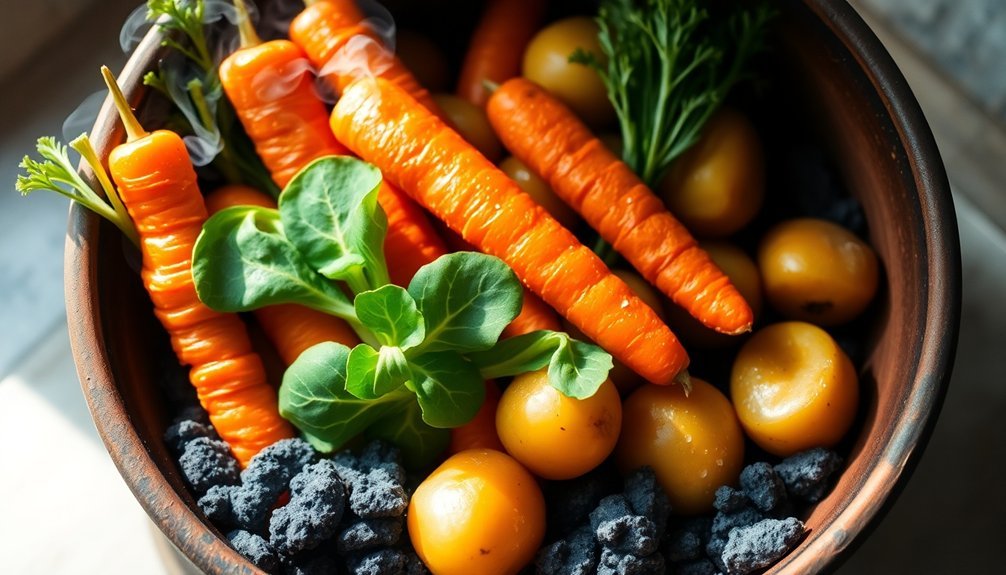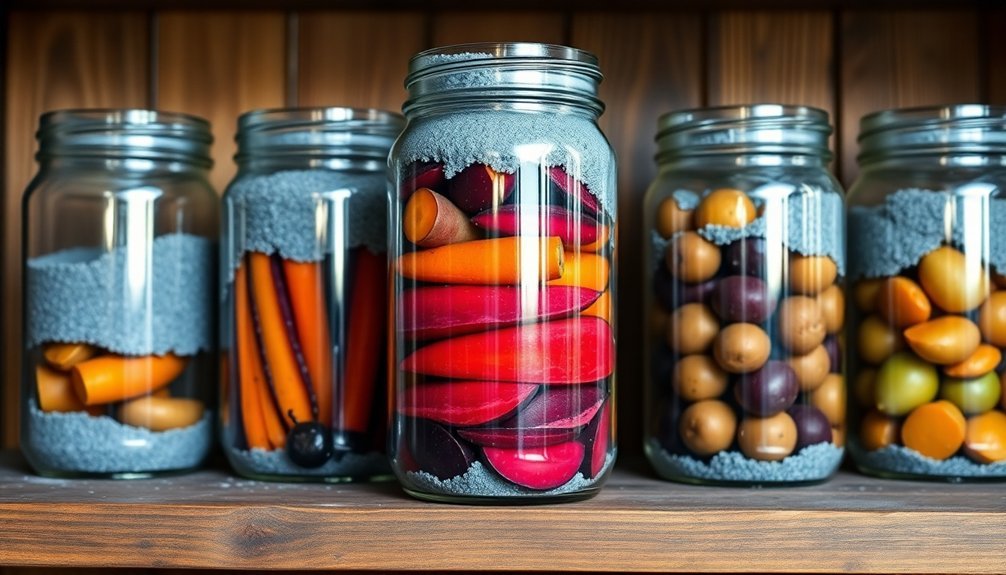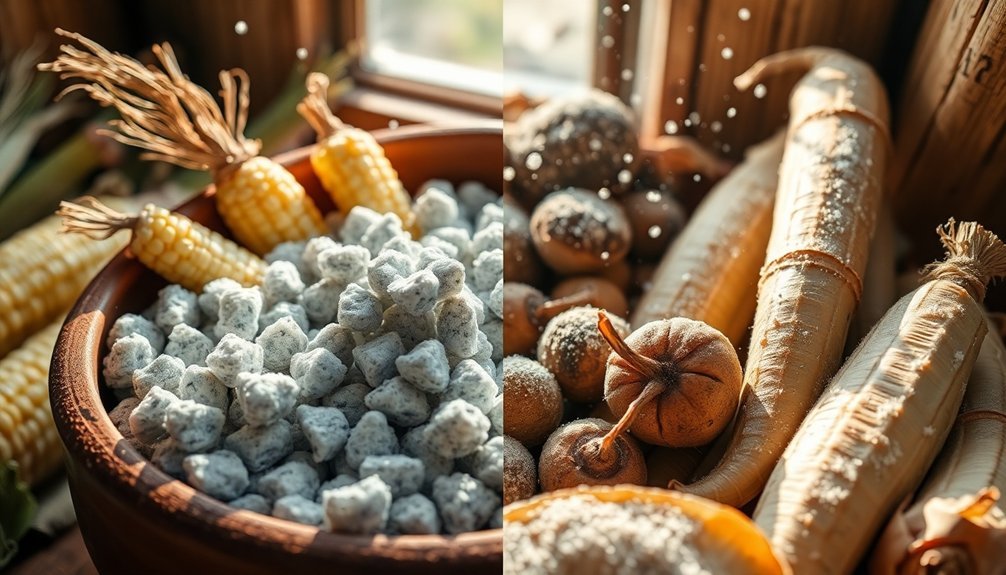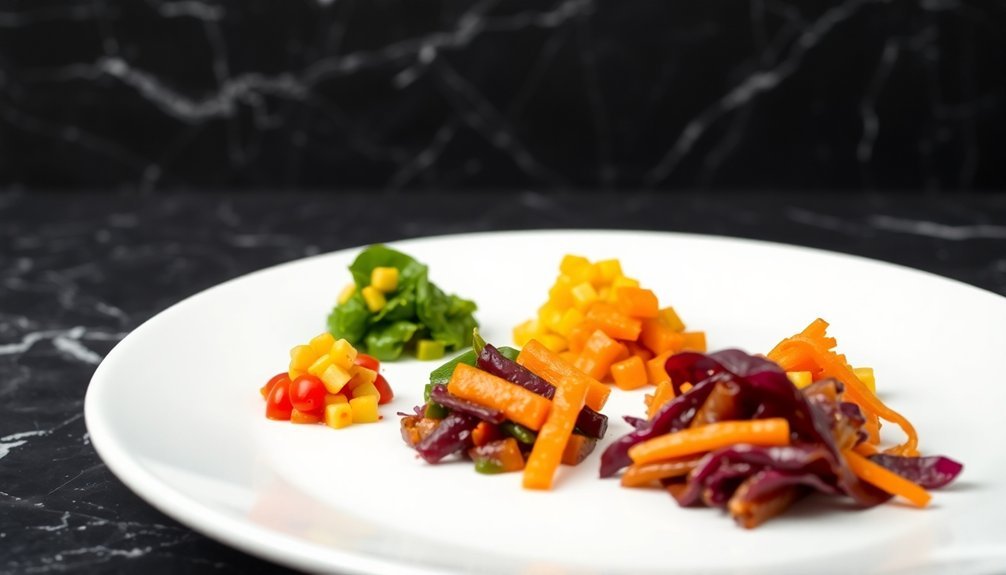Wood ash preservation offers you a natural, cost-effective way to extend your food's shelf life while maintaining essential nutrients. You'll reduce decay rates by up to 80% for produce like tomatoes by using this traditional method that prevents microbial growth. The technique doesn't require special equipment – just ash from your woodstove or biomass burning. You can easily adapt this preservation approach using simple containers like earthenware crockery or cardboard boxes. When paired with proper storage techniques, wood ash preservation helps you maintain food quality without chemical additives. There's much more to discover about this sustainable preservation method.
Maximizing Natural Nutrient Retention

Preserving nutrients in food starts with proper storage and cooking methods. You'll want to store your fruits and vegetables in airtight containers and keep them cool to prevent vitamin loss through enzymatic activity. For peak preservation, maintain high humidity in your refrigerator and minimize air contact with stored foods. Natural preservative compounds can help extend shelf stability while maintaining food quality.
When cooking, opt for methods that retain the most nutrients. You'll get better results by steaming, microwaving, or pan-cooking with minimal water and tight-fitting lids. Keep the skins on fruits and vegetables during cooking, as they help lock in valuable nutrients. Instead of boiling, which can lead to significant nutrient loss, try grilling, roasting, or stir-frying your vegetables.
For long-term storage, freezing is your best option when you can't consume foods within a few days. Before freezing, blanch your vegetables to halt enzyme activity that would otherwise destroy vitamins.
Don't forget to save any cooking liquid for soups or stocks, as water-soluble vitamins often end up there. When using advanced preservation methods, consider high-pressure processing or microwave preservation, as these techniques maintain natural vitamin content while minimizing heat exposure and nutrient loss.
Moisture Balance for Fresh Produce
While proper cooking methods protect nutrients, managing moisture levels plays an equally important role in maintaining food quality. You'll find that excess moisture is one of the primary culprits behind food spoilage, as it creates an ideal environment for bacteria and mold growth. By controlling moisture, you can extend your food's shelf life up to three times longer.
To maintain ideal moisture balance, don't wash your produce before storing it. Instead, store it in airtight containers and use paper towels to absorb excess moisture, especially for leafy greens. Wrapping your greens in a clean dry towel can help maintain optimal moisture levels. You'll want to guarantee proper airflow in your storage containers while keeping them clean to prevent bacterial growth.
Temperature control is vital – store your produce in cool, dry areas to minimize moisture-related spoilage. You can enhance storage conditions by keeping ethylene-producing fruits separate from ethylene-sensitive vegetables.
It's also important to regularly check your produce for signs of excess moisture and remove any spoiled items promptly. By planning your purchases carefully and only buying what you'll consume within three to five days, you'll reduce waste while maintaining the nutritional value of your fresh produce.
Chemical-Free Food Storage Solutions

Natural alternatives to chemical-based storage solutions can protect both your health and the environment. You'll find numerous non-toxic options that effectively preserve your food while avoiding harmful substances found in conventional plastic containers. Glass, stainless steel, and ceramic containers offer safe, reliable storage without leaching chemicals into your food. Studies show that BPS and BPA can disrupt hormonal function when they leach from plastic containers.
- Replace plastic wrap with beeswax or vegan food wraps to maintain freshness while reducing environmental impact.
- Switch to silicone bags and glass containers with silicone seals for versatile, reusable storage options.
- Utilize natural preservation methods like rosemary extract and Kakadu plum to extend shelf life.
For long-term storage, consider investing in high-quality Kilner jars or EcoEvo glass containers that work seamlessly in your freezer, oven, and dishwasher. These alternatives provide excellent preservation while maintaining food safety.
You can enhance their effectiveness by combining them with natural preservatives like garlic or sugar-based solutions. The traditional canning method, using proper heat treatment and vacuum sealing, offers another chemical-free approach to preserve fruits, vegetables, and even meats.
These solutions not only protect your food but also contribute to a healthier, more sustainable lifestyle.
Extended Shelf Life Benefits
Through the strategic use of wood ash, you'll discover remarkable shelf life extensions for various food items. When you apply wood ash correctly, particularly with tomatoes, you can reduce decay rates to as low as 20% using 1.5 kg of ash per 1 kg of produce. This preservation method effectively protects your food from air exposure and deters pests that typically cause spoilage.
You won't need to worry about losing nutritional value either. Wood ash preservation maintains the food's nutrient content by preventing microbial growth, and it doesn't greatly alter the total soluble solids or pH levels of treated foods. Unlike methods requiring electricity, you can achieve these results without refrigeration.
You'll appreciate the practical storage options available with wood ash preservation. Whether you're using earthenware crockery, cardboard boxes, or ground storage, the method is adaptable to various conditions.
As a cost-effective solution, you'll find wood ash readily available from woodstoves or biomass plants. This makes it particularly valuable if you're in rural areas with limited access to modern preservation technologies. The method's simplicity doesn't require specialized skills or equipment, making it an accessible option for long-term food storage.
Sustainable Preservation Methods

Building on the traditional wood ash method, modern sustainable preservation approaches offer you even more options for maintaining food quality.
Today's eco-conscious techniques combine natural preservatives with innovative technologies to protect your food while minimizing environmental impact. You'll find that plant extracts and beneficial microorganisms can effectively preserve food freshness without synthetic additives, while keeping the original flavors and nutrients intact.
- When you choose sustainable preservation methods, you're reducing greenhouse gas emissions and energy consumption, as many modern techniques like cold plasma and UV radiation require less power than conventional methods.
- You'll contribute to waste reduction since these preservation approaches extend shelf life while using biodegradable packaging materials that break down naturally.
- You can take advantage of solar-assisted technologies and smart packaging solutions that monitor food conditions in real-time, ensuring ideal preservation while using renewable energy sources.
Natural preservatives and advanced packaging solutions work together to create a thorough preservation system.
Frequently Asked Questions
Can Wood Ash From Different Types of Trees Affect Preservation Quality?
Yes, you'll find that hardwood ash (like oak) provides better preservation due to its higher nutrient content and alkalinity, while softwood ash (like pine) is less effective at preserving your food items.
Does the Ash Preservation Method Affect the Taste of Preserved Foods?
You'll find that wood ash preservation doesn't considerably change your food's taste. It primarily works to keep moisture out and prevent spoilage, allowing your preserved foods to maintain their natural flavors over time.
What Safety Precautions Should Be Taken When Handling Wood Ash?
You'll need to wear gloves and a mask, let ashes cool for at least 48 hours, store them in a metal container with a tight lid, and keep them away from buildings and flammable materials.
Can Ash-Preserved Foods Be Consumed Directly Without Additional Preparation?
No, you shouldn't consume ash-preserved foods directly. You'll need to thoroughly clean off all ash residue before eating. Always inspect for ash in cracks or crevices and prepare the food appropriately before consumption.
How Can You Determine if Wood Ash Is Clean Enough for Preservation?
You'll know wood ash is clean if you've burned untreated, unpainted wood from trusted sources. Check for a white-gray color, guarantee it's free from debris, and verify it's from residential woodstoves only.
In Summary
You'll find ash preservation offers remarkable benefits for keeping your food's nutritional value intact. By incorporating this time-tested method, you're choosing a sustainable, chemical-free approach that maintains moisture balance and extends shelf life naturally. Whether you're storing fresh produce or preserving dried goods, ash preservation isn't just cost-effective – it's an eco-friendly solution that keeps your food's nutrients at their peak.





Leave a Reply